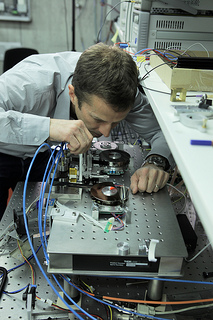
IBM Sets New Record for Tape Storage
IBM scientists have demonstrated an areal recording density of 123 billion bits of uncompressed data per square inch on low cost, particulate magnetic tape, a breakthrough which represents the equivalent of a 220 terabyte tape cartridge that could fit in the palm of your hand. To put this into perspective, 220 terabytes of data is comparable to 1.37 trillion mobile text messages.
This new record demonstrates that computer tape – a storage medium invented in 1952 with an initial capacity of about 2 megabytes per reel -- continues to be a technology not just for storing enormous amounts of back-up and archival data, but for new applications such as Big Data and cloud computing. The record setting demonstration is an 88 fold improvement over an LTO6 cartridge, the latest industry-standard magnetic tape product, and a 22 fold improvement over IBM’s current enterprise class tape product.
 The record was achieved using a new, advanced prototype tape developed by FUJIFILM, in collaboration with IBM scientists.
The record was achieved using a new, advanced prototype tape developed by FUJIFILM, in collaboration with IBM scientists.
"With this demonstration, we prove again that tape will continue to play an important role in the storage hierarchy for years to come," added Evangelos Eleftheriou, IBM Fellow.
While tape has traditionally been used on premise for video archives, back-up files, replicas for disaster recovery and retention of information, off-premise applications in the cloud are beginning to emerge due to its low cost, which averages just a few pennies per gigabyte.
IBM Research scientists in Zurich are exploring the integration of tape technology with current cloud object storage systems such as OpenStack Swift. This would enable object storage on tape and allow users to migrate cold data to a low-cost cloud based storage tier suited for back-up or archival use cases. A research prototype of this technology is being demonstrated next week at the 2015 National Association Broadcasters Show in IBM booth N5223.
To achieve 123 billion bits per square inch, IBM researchers developed a set of servo control technologies that include a high bandwidth head actuator, a servo pattern and servo channel and a set of tape speed optimized H-infinity track follow controllers that together enable head positioning with an accuracy better than 6 nanometers. This enables a track density of 181,300 tracks per inch, a more than 39 fold increase over LTO6.
In addition, an enhanced write field head technology enabled the use of much finer barium ferrite (BaFe) particles.
Signal-processing algorithms for the data channel, based on noise-predictive detection principles, enabled reliable operation with an ultra narrow 90nm wide giant magnetoresistive (GMR) reader.
In addition, the scientists have developed new detection methods to improve the accuracy of reading the tiny magnetic bits, achieving an increase in the linear recording density of more than 76 percent over LTO6, while enabling the use of a reader that is only 90nm in width.
Many of the technologies developed and used in the areal density demonstrations are later incorporated into IBM tape products. Two notable examples from 2007 include an advanced noise predictive maximum likelihood read channel and first generation BaFe tape media.





















